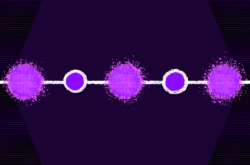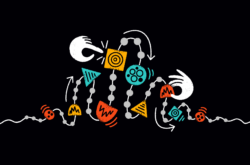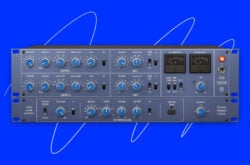Illustration: Nhung Lê
A polyrhythm is when two or more rhythms are being played simultaneously that aren’t derived from the same meter.
Here’s another simple way to think about polyrhythms: you have two rhythms with a different amount of pulses—let’s say four pulses and three pulses, for example—taking up the same amount of time, with the downbeats always lining up. Some of the most common polyrhythms are three-against-two (3:2), which is referred to as a hemiola, and four-against-three (4:3).
Below is a great video from Andrew Huang that will help you count out, feel, and hear polyrhythms with some key visual cues:
Where can you hear polyrhythms?
Polyrhythms pop up in all sorts of styles and genres, some of which you might not expect. In classical music, you’ll often find scores with groupings of notes notated with a slur and a number above them. The number represents the quantity of notes that are supposed to be played in a set amount of time, which would typically be occupied by a different amount of notes. In the Nocturne excerpt below, Chopin wants these eleven notes to be played in the same amount of time taken up by six 1/8th notes:

Many styles of music from Africa and the Indian subcontinent also make use of the technique. Below is an example of Yoruba drumming that incorporates polyrhythms:
Additionally, genres like math rock, IDM, techno, trap, and many others also regularly implement polyrhythms in one way or another. Though they may seem complex on the surface, polyrhythms are all around us; they’ve been around for countless generations, and they’re here to stay.
Why you should care about polyrhythms as a producer
What’s cool about polyrhythms is that they make our ears perk up and capture our attention. They deliver that intrinsic push-and-pull on a rhythm that feels just right, or introduce that tension and release on a musical phrase that makes us feel something.
As producers, getting and maintaining a listener’s attention is one of our main jobs, and a little rhythmic gymnastics via the use of a polyrhythm can be a great way to add life to our music. When handled properly, the technique can provide that additional texture to our tracks that propels things forward and makes listeners really stop and listen.
And fortunately, technology has made sequencing and working with polyrhythms easier than ever before; functionalities like MIDI stretch in Ableton Live can allow you to sequence in 11:7, 12:5, or 7:4 with just the click of a button.
Have you used polyrhythms in your music before? What are your favorite tracks that feature them? Let us know in the comments below.
Learn how to apply polyrhythms in the context of a track with Erin Barra’s in-depth Splice Skills Lesson:
July 8, 2021



